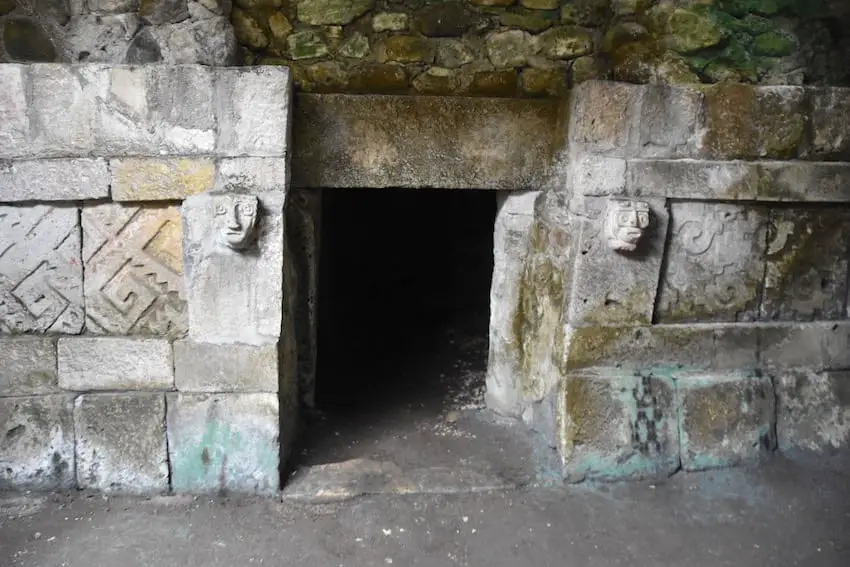The ruins of Yagul, a Zapotec city-state, may not be as impressive as those of Monte Albán – few ruins are – but they’re definitely worth a visit. Yagul is only 38 km (24 miles) southeast of Oaxaca City, just off Highway 190. And because it’s not as impressive or famous as some other sites, visitors often find themselves able to wander around the ruins alone.
Yagul is a Zapotec word meaning Old Stick or Old Tree (although one website translates it as Dry Stick or Dry Tree). The site on which it was built was first occupied by hunter-gatherers, who took shelter in nearby caves around 3,000 BC.

Yagul was first excavated in the 1950s and 60s by Ignacio Bernal, Lorenzo Gamio and John Paddock. Bernal and Gamio were two Mexican archaeologists whose work focused on excavating sites in the Valley of Oaxaca; Paddock was an American archaeologist who also worked extensively in Oaxaca.
Yagul was built on a small hill with a fortress on top of it. The buildings on the hill’s slopes, including palaces and temples, served as the city’s administrative and religious centers. Houses line the base of the hill.
The oldest buildings that have been excavated date to somewhere around 500 A.D. and the majority of the structures were built during the Postclassic Period, which lasted from 900 to 1521 A.D. Yagul, like the nearby sites of Mitla, Daizú, and Zaachila, arose following the decline in 850 AD of Monte Albán, then the capital city of the Zapotec civilization. Yagul grew into a local power and governing center and maintained its grip on the region until the arrival of the Spanish in 1521. Yagul, with a population of 6,000, was abandoned at that time, and most of its residents moved to nearby Tlacolula.
A common feature of Zapotec cities was that tombs were built under houses. So far, thirty tombs have been discovered at Yagul, and the Triple Tomb should be the first one you visit.

As the name suggests, the Triple Tomb consists of three tombs – designated 3, 29 and 30 -all looted during the pre-Columbian era. The tombs are open to visitors and are accessed via a short staircase leading to a small, damp room. On either side, tomb 30 is decorated with small carved heads similar to those found on buildings at Mitla, another ruin about 9 kilometers (about 5.5 miles) away from Yagul. Although Yagul was a Zapotec city-state, Bernal and Paddock came to believe Mixtecs built the tombs. This caused a bit of a stir among archaeologists, and the debate over who built them has not yet been settled.
The tombs are very similar to the ones I visited in Zaachila several years ago – with one big exception. I visited right after the Day of the Dead. The tombs at Zaachila had carvings different from those at Yagul, including a bird (possibly an eagle) and a human with either a shield or a turtle’s shell on his back. But the different carvings weren’t the big exception. I noticed some dark spots as I looked more closely at the bird. I leaned in and although I can’t swear to it, they looked an awful lot like dried blood. I cut my visit to those tombs short.
Near the Triple Tomb at Yagul is a large rock carving of a frog, an image associated with water or rain.
Like many pre-Hispanic cities, there’s a pelota court. In fact, Yagul has the largest pelota court – yet to be uncovered – in the Valley of Oaxaca and the second largest in Mesoamerica. Only the court at Chichén Itza, in Yucatán, is more extensive. The ball court is aligned east to west, typical of those constructed during the Middle Classic period (550 to 700 AD). Earlier courts were generally aligned north to south.

The Palace of Six Patios is considered the most exclusive residence in Yagul, with its six interconnected patios forming one large quadrangle. The structures were built using stones covered with mud and then painted. These and other buildings were once painted red, although now, at least to my eye, they have faded to yellow.
Patio 1, located in the southern part of Yagul, contains three structures. The large Council Hall is located on the north side and is where the city’s rulers met. The palace is to the west and the area where the city’s rulers lived is to the east. The walls of these structures, like the walls of others at Yagul, were covered with stucco and painted red. Two tombs where several rulers had been buried were discovered near the living areas.

Yagul can be explored in about an hour. Since there are two other nearby sites along Highway 190, it’s possible to visit all three in one day. The best idea would be to start at Mitla, the furthest from Oaxaca. Yagul is 9 kilometers (5.6 miles) from Mitla and Daizú is 15 kilometers (9.3 miles) from Yagul. From there, it’s only about a 30-minute drive to the city of Oaxaca. Bring water, sunscreen, a hat, and comfortable walking shoes if you decide to tackle all three -or even just one.
Yagul is open Monday through Friday from 10 a.m. until 4 p.m. There’s a 90-peso entrance fee.
Joseph Sorrentino, a writer, photographer and author of the book San Gregorio Atlapulco: Cosmvisiones and of Stinky Island Tales: Some Stories from an Italian-American Childhood, is a regular contributor to Mexico News Daily. More examples of his photographs and links to other articles may be found at www.sorrentinophotography.com He currently lives in Chipilo, Puebla.
